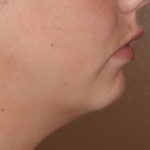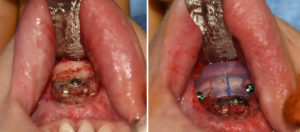Background: The sliding genioplasty is a well known chin augmentation procedure that is often viewed as a substitute for a chin implant. While this is certainly true in some patients, for other patients it is a better alternative as both an autologous operation and because it can offer some dimensional chin changes that an implant has historically not been able to do.
One dimensional limitation of this bony genioplasty operation is that the amount of horizontal augmentation obtainable is controlled by the thickness of the bone. To ensure bony healing as well as survival of the downfractured chin segment, bone contact must be maintained. This means that the maximal amount of horizontal bone movement is that the back cortex of the mobilized chin segment must stay in contact with the front cortex of the intact chin bone above it.
Because of this anatomic limitation not every sliding genioplasty can achieve ideal chin projection. This leaves the role of a chin implant to achieve an even better chin augmentation result.


There is no reason that an implant can not be placed on top of a prior sliding genioplasty. This would be the simplest way to improve a prior bony chin augmentation procedure. With the many styles of chin implants now available many alloplastic options exist to change the shape of the prior remodeled chin bone.
Highlights:
1) A sliding genioplasty does not always create the ideal horizontal position of the chin particularly in significant lower jaw deficiences.
2) A chin implant can be a secondary addition to a prior sliding genioplasty.
3) The extended wings of a chin implant can help camouflage any bony irregularities along the jawline from the prior sliding genioplasty.
Dr. Barry Eppley
Indianapolis, Indiana


